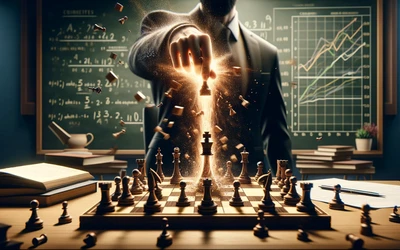
AI generated
An appreciation of Aron Nimzowitsch - one of the greatest Hypermodernists
One of the great Hypermodernists who really influenced the evolution of chess style and openings with his games and teachings in "My system"Hi all,
I would love to share some of my enthusiasm for Hypermodern chess and its related concepts in this blog post. My favourite hypermodernist is Aron Nimzowitsch. Or for a long time I have spelled his name as "Nimzovich" because it seemed easier.
Who are the Hypermodernists?
The Hypermodernists are arguably most associated with concepts such as the indirect control of the center - e.g. using Fianchettoed bishops contrasting with the literal occupation of the center with pawns. Also, they are associated with provoking the opponent to occupy the center so they could destroy it later.
The leading hypermodernists are considered to be:
Aron Nimzowitsch
Richard Reti
Saveilly Tartakower
Gyula Breyer
I would consider the practicing hypermodernists to include:
Efim Bogoljubov
Ernst Gruenfeld
Breyer famously wrote after 1.e4
“White’s game is in its last throes"
This provided greater support for the notion of considering alternative start moves particularly 1.Nf3
The Reti opening is considered the move sequence 1.Nf3 d5 2.c4 :
The Nimzo-Indian is a prime example of a successful hypermodern opening along with the Reti which modern Grandmasters frequently use.
A good way of describing these "Hypermodern" openings is that they "embody" the concepts of the hypermodernists. And they can quite often use many of the concepts within Nimzowitch's "My System". E.g. if you get to double the opponent pawns, then you can blockade them later, etc.
The biggest gift: The Spirit of finding Useful Exceptions
But what the Hypermodernists give which may be even greater use to the chess world and future generations is the desire to find "useful exceptions". See what theory represents and react to it.
Don't just accept it but experiment with it. Can Goal A be achieved by Method A, Method B, and Method C. Does it always have to be achieved by Method A. Is Method A a "Golden rule" or just a bit of guidance?
Chess is a concrete game after all. But with that extremely rich set of possibilities, there are also elegant positional abstractions too. We don't want to have Kodak moments if we were running a company right? What if there is a better way of doing photos. What if there is a better way of controlling the center rather than just occupying it? Etc.
Nimzo is much more than an Opening heritage
For me, the Hypermodernists - well in particular Nimzowitsch provided much more than just an opening heritage. I would like to talk about in this blog one of the leading Hypermodernist - Aron Nimzowitsch (1886-1935)
Aron Nimzowitsch, a Latvian-Danish chess grandmaster, is one of the most influential figures in the history of chess, particularly known for his foundational role in the Hypermodern movement. His contributions to chess theory profoundly altered the landscape of the game in the 20th century and beyond.
It's all in the follow-up after the opening
Influential Books by Nimzowitsch
"My System": Nimzowitsch's book "My System," published in 1925.
"Die Blockade" was published in 1925 (considered somewhat of a rehash of "My System").
"Chess Praxis" - originally published in German in 1929 and was purchased by future World chess champion Tigran Petrosian.
Out of the three, "My System" is considered to be one of the most influential chess books of all time and certainly one I tried to experiment with. And at first, not too successful until I added an ingredient question of asking "Is it really exploitable". For example "Are the doubled pawns here really exploitable?". A danger of such a conceptually rich book can be in practical application to one's own games, so it needed a time of finding the ups and downs of the ideas presented.
However, aside from the initial pain of conceptual shocks, Nimzovich in "My System" created a book that you could argue was a positional chess book oriented to make the best out of Hypermodern openings. So for example in the Nimzo-Indian, if we can get to double the opponent's pawns, then we can use concepts like Blockade and restraint generally. Nimzovich had fantastic game examples where he showed this in action. And it gave him great options. He could either blockade and destroy weak pawns, or perhaps just conduct a K-side attack knowing that his Q-side was safe.
A lot of players today seem to like memorizing particular opening lines with no idea of what is to come next in terms of key plans and ideas. When we read a book like "My System" by Nimzowitsch or "Simple chess" by Stean, we equip ourselves more for the middlegame and endgame. Positional chess books are important. The evaluation given by engines means very little in practice if we can't "follow up" correctly later in the middlegame and the endgame if the game reaches that far.
Gateway to new positional concepts in effect
The premise of controlling the center from afar may not win you many games in itself. It could influence your choice of opening. But what about playing strong moves and ideas later beyond the opening? Here personally one of my favorite middlegame concepts is to find downsides of the opponent's positon and ruthlessly capitalise on those! I find that also checkmate ends the game!. So how does this abstract notion of the center really compete with that?
What has really happened with the Hypermodernsits like Nimzovich by researching new openings, have kind of opened up a good can of positional concepts - like blockading for doubled pawns which might arise naturally from the Nimzo Indian Defence:
The above diagram shows a typical dark square strategy and trying to blockade c4. Maybe later c4 can be "restrained, blockaded and destroyed".
Nimzowtisch hit gold with the Nimzo-Indian defence - even in modern times, Stockfish thinks it's a great way to equalise with black. But if you don't get "My system" - will you really know the deeper middlegame ideas and concepts of it?
Prophylaxis - a brilliant alternative to accumulating advantages
What I love about Nimzowitsch in particular was trying to be a contrarian. This can be very annoying for some to tolerate I expect. And it helped he had a bitter rival in the form of Siegbert Tarrasch. but it wasn't just the classical notation of the center and its occupation under fire. What if we didn't even need to accumulate advantages which Steinitz talked about in the classic positional school of chess?

What if we could just continually put ourselves more and more beyond defeat - what if we could give our position more and more security and strength? I.e. What if we applied extreme prophylaxis instead of accumulating advantages? Like putting pawns in the center - that could have a downside.The pawns could be targeted. When we try and accumulate an advantage - that implies doing something active - what if we left a piece unprotected in the process, or got back-row mated? Maybe we could have just played an improving move first like h3 as long as it couldn't be exploited. The very act of "doing stuff" could be just as much a downside as occupying the center with pawn.
It is these "useful exceptions" to established theory which may not be talked about as much by the other Hypermodernists such as Reti.
Nimzowitsch introduced the concept of prophylaxis in chess - anticipating and countering the opponent's threats before they are fully realized. This idea of preventive strategy was a departure from the more direct approach of simply accumulating advantages which was laid out by Steinitz in the Classical school of chess. Future World chess champions like Petrosian who really didn't like losing, perhaps really embraced this more than most other players. Why not just suffocate opponents like a Python instead of doing potentially risky moves trying for too much and too soon?
As example if Nimzovich did get to double the opponents pawns, not only could they be blockaded, but maybe also any threat potentially could be prevented, thus giving Nimzowitsch a free hand to say attack on the K-side.
On the other hand in this iconic Nimzo game, doubled pawns can also lead to a mighty outpost on c4:
Preparing pawn breaks and other potentially double-edged stuff
In the engine world, there have been games of the lc0 neural network where it seems about 30+ moves of preparation are made before a pawn break. Maybe the pawn break does promise some advantage but what if the 30+ moves of preparation made sure most of the major downsides were taken out? Then you could "Have your cake and eat it!". Prophylaxis! Prophylaxis! Prophylaxis! But perhaps not good for lichess online blitz where you want to try and win fairly quickly.
Overprotection
Overprotection: Another key idea from Nimzowitsch was overprotection, the strategy of strongly guarding a key point - especially e5 as White or e4 as black.

The Nimzowitsch Gambit is directly underlining the concept:
In the above diagram, Nimzovich has won games by reinforcing the e5 point and driving away a knight coming to g6 to in effect loosen the opponent's grip on e5. Such a grip can be more convincing than say a Maroczy bind. It can reduce the opponent's counterplay significantly. There happens to be a good recipe against this Gambit though - but most players online won't know it. Example game:
Blockade
Nimzowitsch also emphasized the importance of blockade. He showed how blockading an opponent's pawn structure could lead to a strategic advantage, providing a foundation for eventual victory.
Nimzoviche's favorite blockade - a Knight - of course. When we play the Nimzo Indian we also often get an extra knight to the opponent's bishop. But not just that the knights can attack points within the opponent's position as well as do blockading duty. Nimzovich brought all of these ideas to life in "My System".
Openings Legacy
Nimzowitsch's opening legacy includes:
Nimzo-Indian Defence
The Nimzo Larsen Attack
The Nimzowitsch Defence to 1.e4
The Sicilian Nimzowitsch
The Nimzowitsch Gambit in the advance french
and more.

These openings are like gateways for us to exercise particular positional concepts as this blog tried to highlight. Without "My System" you might technically be playing a hypermodern opening, but are you playing with the great ideas of the middlegame that "My System" alluded to? Of course, you could also study Nimzo's games in detail too.
One word of caution: "Checkmate ends the game".
We have to be careful when playing certain hypermodern openings especially when Black vs 1.e4. The Hypermodern openings tend to work better vs 1.d4 because e4 is a natural weakness. With 1.e4, there isn't so much an associated weakness on d4 as the Queen protects it.
Hypermodern black openings like the "Modern" and the Pirc can risk King safety. It is good not to get viciously attacked on the h-file. Additionally, a fianchetto bishop comes with costs. If it is exchanged off you can be left with fatal weaknesses. This is also made worse when playing black and the opponent has the initiative and greater possibility to exchange off your fianchetto bishop. Nimzovich most of the time managed to keep his King safe.
There are some principles in chess to which there aren't any useful exceptions - and "Checkmate ends the game" is one of them. Not so game-ending but you could argue that the provocative Hypermodern openings like the Alekhine defense play on another truism "Pawns don't go backwards". And "A blockaded pawn can't move forward". These truisms make for the best principles so that chess doesn't just become about pure calculation. There are some solid principles you can make use of. Other principles really should be treated as guidance as chess is a very concrete game.
Explore My Chess Courses
For more chess strategies and insights, visit https://kingscrusher.tv
Enjoyed this post? Your likes and follows are immensely appreciated!
Cheers, K
More blog posts by Kingscrusher-YouTube

Epic Top 100 Finish in Lichess Spring Marathon!
Some hints, tips, observations from the Spring 2024 marathon which was a 5 minute time control
Supercharge Your Chess Tactics by Punishing Mistakes
Mistakes are what makes chess fun especially at lower levels. We need to be really good at punishing…
The importance of Chess Visualisation skills
Reminders abound for the importance of chess visualisation skills
